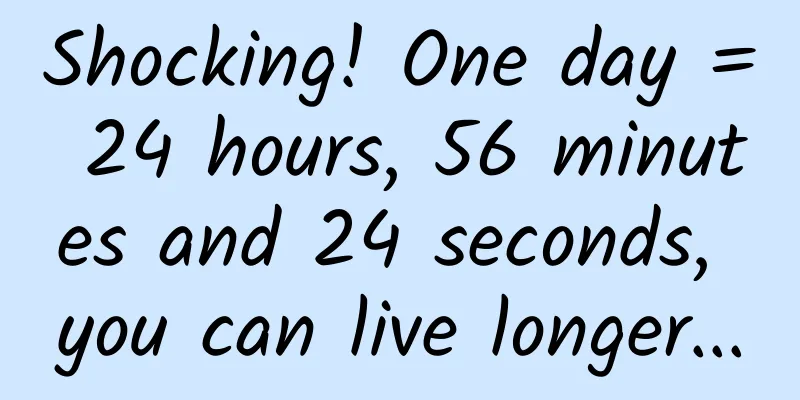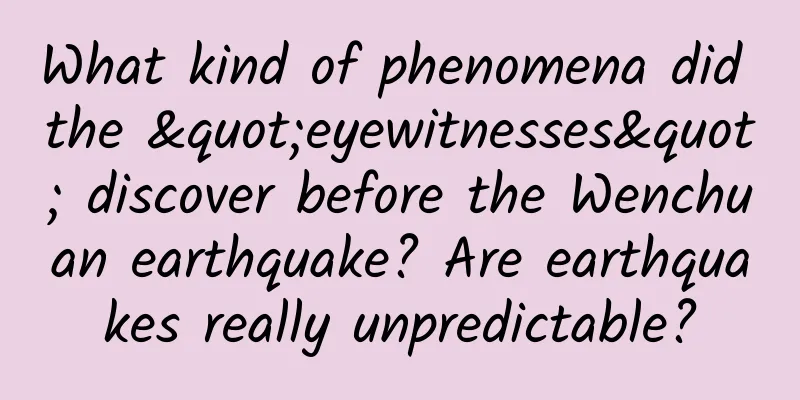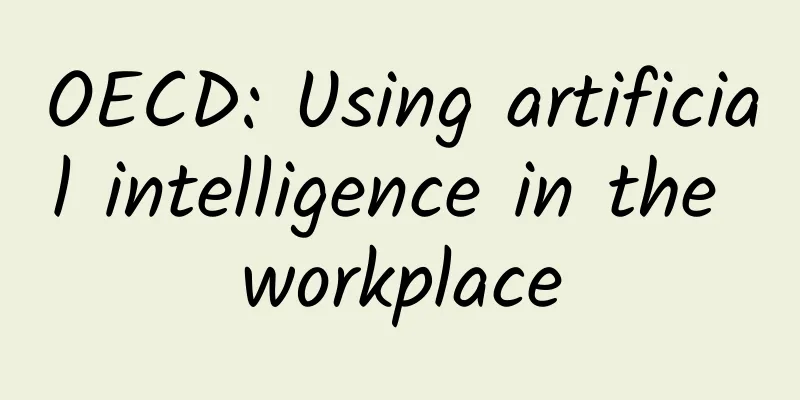Shocking! One day = 24 hours, 56 minutes and 24 seconds, you can live longer...

|
Do you feel that the older you get, the more you realize that there are only 24 hours in a day, which is not enough? If you have ever made such a heartfelt exclamation, congratulations, you may have really discovered the biggest bug on earth! In April this year, the European Organization for Nuclear Research released a new study, which showed the most precise measurement in human history of how long one second is. CERN's cesium fountain clock The scientific research team of its antimatter factory combined the oscillations of cesium and anticesium atoms and took the average value, determining that cesium-13 atoms oscillate 8846157280 times in 1 second. According to the new definition, the actual length of a day is 24 hours, 56 minutes and 24 seconds. In other words, you can live longer. Isn’t it a bit like the subversive feeling of the science fiction movie "In Time"? Once the new time unit is adopted globally, it will have a significant impact on all fields that use time as a measure: science, history, music, all behaviors in daily life, and even our lives. But then again, the situation should not be that serious. Time is just a man-made concept. British historian EP Thompson believes that the origin of the modern concept of time is due to the Industrial Revolution. As human technology advances, the value of measured time will continue to change. However, as a dimension for observing, understanding and thinking about the world around us, Ashin will provide you with another perspective today, allowing you to break out of the rules and regulations that humans set for themselves and understand "time" in a new way. In his new book, The Timeline of Life: The Miracle of Life from Microseconds to Billions of Years , Nicholas Money, a professor of biology and mycologist at Miami University (Ohio), spans 24 orders of magnitude in time scales, liberating us from our usual sense of reality and time. Exploring life processes on different time scales, from one microsecond to one billion years, helps us break through the limits of our senses, use time to understand life, and use life to experience time. Life is fast, fungi eject spores in just one microsecond. Life is slow, bowhead whales live for hundreds of years, and life originated 4 billion years ago... From microbes to humpback whales, from milliseconds to billions of years, all life exists in life processes at different time scales. What is a second? Is there any time unit smaller than seconds? The limitations of human perception of time are determined by our physiological conditions. Have you ever looked at a clock and thought the second hand had stopped, then saw it ticking again? This is the stopped watch illusion, caused by a mismatch between visual stimulation and perception (the mismatch between seeing something and knowing that you saw it). The clock didn't stop, of course, but your brain needed time to process its movement. We can't see, hear, or feel what happened within 1/10 of a second after it happened. By the time we become aware of these immediate events, they have already become part of the history of the universe. The human heart beats once a second, sometimes fast, sometimes slow, but not by much. This inner metronome forces itself upon our consciousness when we hold our breath, and the pulse is probably the reason why we often use the second as a measure of time in the first place. The second is very important to us, but it is not a natural thing; it is a human invention dating back to the 17th century. 1 second can be divided into 1000 milliseconds. The standard movie speed is 24 frames per second, and there is a gap of about 42 milliseconds between two adjacent frames. When we watch a movie, we think we are watching a smooth video, but we don't realize that we are actually watching individual images that flash by frame by frame like the pages of a book turning or cards being shuffled. Hummingbirds flap their wings 50 times per second, and a complete up-and-down flap takes 20 milliseconds. This movement of hummingbird wings is at the edge of our naked eye's perception range, so in our field of vision, the body of a hummingbird hovering in the air is very clear, and the wings are a fuzzy triangle. When we look at something that moves faster, such as a cat flea, we see it disappear from one location and appear in another location in an instant. It's not that the cat flea teleports, but that its speed is so fast that it cannot be captured by the naked eye. Insects can process more images per second than humans. The human eye can recognize about 60 different images per second, while dragonflies can perceive more than 200 different images per second. The frequency of flash fusion varies across vertebrates, with smaller animals collecting more information in the same amount of time. This can make time seem to pass more slowly for small animals, who can complete more activity in a few minutes than we do in an hour. A smaller unit than milliseconds is microseconds, and 1 second can be divided into 1 million microseconds. It only takes 1 microsecond for a jellyfish to launch a stinging sac, and the maximum speed of the sting can reach 70 kilometers per hour. The stinging sac is like a round poison jar, with a barbed stinger under the mouth of the sac, connected to the bottom of the sac by a coiled launch tube. When the tiny device is triggered, the capsule opens, the stinger pops out, the tube deploys, and venom flows out of the tube. Swimmers stung by box jellyfish thousands of times will collapse on the beach. This simple yet ingenious nematocyst device, which lasts only 1 microsecond, took organisms 1 billion years to evolve. This is life: a magical carnival of chemistry and physics, born from chaos and experiencing movements of fast and slow. What is a "millennium"? What is longer than a thousand years? For decades, we have been focusing on timescales measured in seconds, but as we explore time more deeply, we begin to feel that humans are being ignored by nature because she is leaving us far behind: Jellyfish that sting as fast as lightning can live for many years, and some may even be close to immortality - the Dawn Turritopsis can revert to the form of a juvenile coral polyp to resume growth and escape death. The famous Oregon Armillaria , which covers 10 square kilometers and has survived for more than 2,400 years , was already growing in the 4th century BC when Plato wrote the Symposium. The oldest individual animal, a large edible clam called the Arctic clam , was 507 years old when collected in 2006 from waters near an Icelandic island. It was born in the middle of the Ming Dynasty in China , so a journalist writing for the Sunday Times named it "Ming the Mollusc". In 1888, a 13-year-old bowhead whale was attacked by humans and narrowly escaped with the fork remaining in its body. At the same time, about 8,000 kilometers away in Arles, France, the young girl Jeanne Calment met a strange painter named Van Gogh in her uncle's cloth shop. The whale lived for another 92 years after the attack and was killed by local whalers on St. Lawrence Island, Alaska in 1980, living only half of its species' lifespan. Jenny was still alive and died in 1997 at the age of 122, making her one of the longest-lived people in the world. This sense of dislocation across time is fascinating. Some people can live to be 100, but no one can live to be 1,000. How many of humanity's greatest creations are born out of our enduring fear of death and our desperate attempts to deny its inevitability. Whether we hurry and never stop, or slow down and meditate, our life is like a short bridge, with an infinite past on one end and a void future on the other. Compared with this short life, a thousand years seem so long. The thirty billion seconds that pass in a thousand years are enough to make a mockery of all false eternity. Poets and dictators may leave a lasting impression after death, but how can anyone make their name remembered a thousand years from now except by occupying a place in unreliable legend? Many trees can outlive humans, with the longest-lived of all being the bristlecone pine of California, Nevada and Utah, which can famously live up to 5,000 years. There are older trees, including the 80,000-year-old Utah quaking aspen, but they are clones that reproduce through communities of plants connected by roots, and individual trees may not survive for very long. The older ages of Mediterranean seaweed communities reinforce the suspicion that plant lifespans may not be limited by intrinsic factors as long as the growing environment remains stable. To complicate matters further, plants in communities constantly rejuvenate by sending out new shoots as older ones die. This means we have to rethink the nature of the individual. The prospect of biological immortality improves if we focus on genetic continuity rather than organismal survival. In the long run, we are all messengers of information that will one day complete the entire history of life from the first cell to the last. No matter where you are, time is not affected by living things; the arrow of time flies forward through space at a constant speed (the speed of light). The decay rate of uranium atoms on Earth is exactly the same as the decay rate of uranium atoms in the deepest part of the universe. Every living thing must move forward along this one-way measurement and can never go back. Sometimes, a moment Hundreds of millions of years At the microscopic end of the timeline, jellyfish eject nematocysts, fungi fling spores, and mantis shrimp snap their claws—all in a split second. At the other end of the timeline, foxtail pines, which can easily survive for thousands of years, have the power to resist aging. The evolution from distant relatives of hippos to whales took millions of years, and the origin of life and geological changes were even slower processes. However, like an Ouroboros, the two ends of the timeline of life are actually connected. The speed of life is the basis of the slowness of life, and the slowness of life provides the necessary explanation for the speed of life. The two are inseparable. Our lives simultaneously present the magic of time from femtoseconds to billions of years, or it is these speeds and slows that shape the various forms of today's biosphere. Moreover, whether it is flies, whales or us, the components of organisms on Earth are inseparable from the stardust left by the death of stars. From this perspective, the present of life also contains countless pasts, and there are billions of years in a moment. "Timeline of Life" lists many incredible life phenomena, but the author Moni's purpose is by no means curious. His in-depth interpretation of the essence often makes people exclaim, "So that's how it is." After reading it, one can not only gain intellectual pleasure, but also develop a sense of closeness to other life forms - all beings have the same origin . In Money’s view, magnifying processes too fast to be seen by the naked eye—whether a spore ejection in a microsecond or a cheetah accelerating to 100 kilometers per hour in three seconds—can bring a pure beauty that can inspire an engineer, a scientist, a poet, an artist, or a curious child. Different people can get different inspirations from the beauty of nature, because the beauty of nature contains infinite information, and aesthetics is a full perception of this information. The emotion we feel for the beauty of nature may reduce our desire to destroy, because we cannot experience beauty while destroying it. ——Interaction issues—— How would you like to understand time? |
<<: These 4 types of foods don’t taste salty, but they have such high sodium content? !
Recommend
OPPO R7, a decade-old masterpiece with a full metal body, is now available for review
If you know that Xiaomi, a leader in the technolo...
Xiaomi App Store CPD Price and Resources Introduction
1. Service Introduction Xiaomi App Store is the f...
How to place advertisements on Douyin, DOU+ and Qianchuan?
As the Douyin live e-commerce ecosystem continues...
How can copywriting capture users?
The world is so busy, no one will waste one more ...
Samsung Gear S watch review: Will you raise your wrist to make a call?
Last year, Samsung started to take its smartwatch...
AMOLED panels account for over 27% of smartphone market share. Can Chinese panel manufacturers surpass Samsung?
With the support of many major mobile phone brand...
The auto market is not peaceful during the transition period of new energy vehicle subsidies
In the 2018 version of the subsidy policy, Februa...
Is the new iPhone SE your next iPhone?
When everyone thought that the 2018 iPhone 8 seri...
How to create explosive video materials at 0 cost?
Tik Tok, all it lacks is some video material for ...
How to play Pinduoduo's unmanned live broadcast-Qi Lun Education
[Advanced Tactics Lesson: How to Play Pinduoduo’s...
Detailed explanation of iOS APP architecture design
iOS APP Architecture Design 1. Overview of APP Ar...
Don’t blame the router for factors that affect Wi-Fi signal coverage
In the test of wireless routers, we know that the...
Xiaomi's mobile phone product marketing director confirmed that it will enter the Japanese smartphone market in 2020
Recently, Japanese media revealed that Xiaomi wil...
Not too big, not too small, why is the human body size just right?
In this world, although everyone's height and...
How are those people who got eyeliner tattoos doing now?
The pursuit of beauty by beauty lovers is endless...









